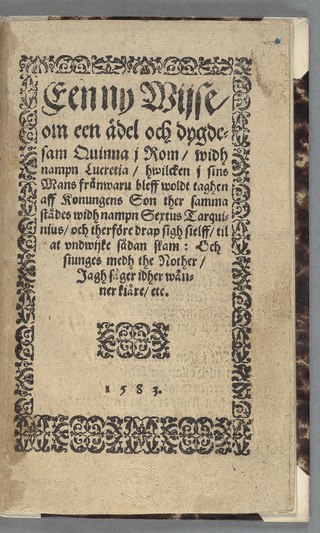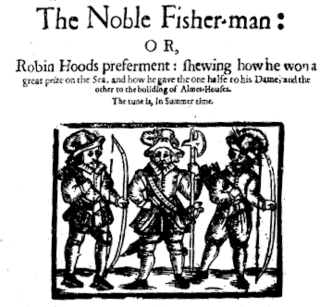Related Research Articles

Robin Hood is a legendary heroic outlaw originally depicted in English folklore and subsequently featured in literature and film. According to legend, he was a highly skilled archer and swordsman. In some versions of the legend, he is depicted as being of noble birth, and in modern retellings he is sometimes depicted as having fought in the Crusades before returning to England to find his lands taken by the Sheriff. In the oldest known versions, he is instead a member of the yeoman class. Traditionally depicted dressed in Lincoln green, he is said to have robbed from the rich and given to the poor.

A broadside is a single sheet of inexpensive paper printed on one side, often with a ballad, rhyme, news and sometimes with woodcut illustrations. They were one of the most common forms of printed material between the sixteenth and nineteenth centuries, particularly in Britain, Ireland and North America because they are easy to produce and are often associated with one of the most important forms of traditional music from these countries, the ballad.
Robin Hood's Chase is Child ballad 146 and a sequel to Child ballad 145, "Robin Hood and Queen Katherine". This song has survived as, among other forms, a late seventeenth-century English broadside ballad. It is one of several ballads about the medieval folk hero that form part of the Child Ballads, a comprehensive collection of traditional English and Scottish ballads.
"Robin Hood's Progress to Nottingham" is Child ballad 139, an original story that is part of the Robin Hood canon. This song has survived as, among other forms, a late 17th-century English broadside ballad, and is one of several ballads about the medieval folk hero that form part of the Child ballad collection, which is one of the most comprehensive collections of traditional English ballads.
Robin Hood and the Tanner is Child ballad 126. It is a late seventeenth-century English broadside ballad and one of several ballads about the medieval folk hero Robin Hood that form part of the Child ballad collection, which is one of the most comprehensive collections of traditional English ballads but has now been subsumed and surpassed by the Roud Folk Song Index.
Robin Hood and the Butcher is a story in the Robin Hood canon which has survived as, among other forms, a late seventeenth-century English broadside ballad, and is one of several ballads about the medieval folk hero that form part of the Child ballad collection, which is one of the most comprehensive collections of traditional English ballads. It may have been derived from the similar Robin Hood and the Potter.
Robin Hood's Golden Prize is Child ballad 147. It is a story in the Robin Hood canon which has survived as, among other forms, a late seventeenth-century English broadside ballad, and is one of several ballads about the medieval folk hero that form part of the Child ballad collection, which is one of the most comprehensive collections of traditional English ballads.
Robin Hood's Delight is Child ballad 136. It is a story in the Robin Hood canon which has survived as, among other forms, a late seventeenth-century English broadside ballad, and is one of several ballads about the medieval folk hero that form part of the Child ballad collection, which is one of the most comprehensive collections of traditional English ballads.
Robin Hood and the Bishop of Hereford is Child ballad 144.

The Noble Fisherman, also known as Robin Hood's Preferment and Robin Hood's Fishing, is a 17th-century ballad of Robin Hood. Unusually, it depicts Robin Hood as a hero of the sea, rather than his usual portrayal as someone who operated in the greenwood forest. It seems to have been quite popular for the first two centuries of its existence, although it eventually lost prominence and was less used in adaptations of Robin Hood from the 19th and 20th centuries. It was later published by Francis James Child in the 1880s as Child Ballad #148 in his influential collection of popular ballads.
King Edward the Fourth and a Tanner of Tamworth is a ballad first found in the Child Ballad collection, number 273. A ballad of this title was licensed in 1564. Versions of this ballad also exist outside the Child collection. Additional copies can be found at the British Library, the University of Glasgow Library, and the Pepys Library at Magdalene College. These ballads dates, by estimation of the English Short Title Catalogue, range from the early seventeenth century to as late as 1775. The ballad is most recognized by its opening line: "In summer time, when leaves grow green." Child describes the appeal of this ballad to be centered on the chance meeting with a King, which is also a recurring theme in tales of Robin Hood.
Robin Hood and the Shepherd is a story in the Robin Hood canon which has survived as, among other forms, a late seventeenth-century English broadside ballad, and is one (#135) out of several ballads about the medieval folk hero that form part of the Child ballad collection, which is one of the most comprehensive collections of traditional English ballads.
"Robin Hood and the Beggar" is a story in the Robin Hood canon which has survived as, among other forms, a late seventeenth-century English broadside ballad, and is a pair out of several ballads about the medieval folk hero that form part of the Child ballad collection, which is one of the most comprehensive collections of traditional English ballads. These two ballads share the same basic plot device in which the English folk hero Robin Hood meets a beggar.
"King John and the Bishop" is an English folk-song dating back at least to the 16th century. It is catalogued in Child Ballads as number 45 and Roud Folk Song Index 302.
An itinerant poet or strolling minstrel was a wandering minstrel, bard, musician, or other poet common in medieval Europe but extinct today. Itinerant poets were from a lower class than jesters or jongleurs, as they did not have steady work, instead travelling to make a living.
"The Lamentable and Tragical History of Titus Andronicus,"also called"Titus Andronicus' Complaint," is a ballad from the 17th century about the fictional Roman general, Titus, and his revenge cycle with the Queen of the Goths. Events in the ballad take place near the end of the Roman Empire, and the narrative of the ballad parallels the plot of William Shakespeare's play Titus Andronicus. Scholarly debate exists as to which text may have existed first, the ballad or the play. The ballad itself was first entered on the Stationers' Register in 1594, the same year the play was entered. Surviving copies of the ballad can be found in the British Library, in the Huntington Library, and at Magdalene College, Cambridge. Online copies of the facsimiles are also available for public consumption at sites such as the English Broadside Ballad Archive.

Robin Hood and Little John is Child ballad 125. It is a story in the Robin Hood canon which has survived as, among other forms, a late seventeenth-century English broadside ballad, and is one of several ballads about the medieval folk hero that form part of the Child ballad collection, which is one of the most comprehensive collections of traditional English ballads.
The English Broadside Ballad Archive (EBBA) is a digital library of 17th-century English Broadside Ballads, a project of the English Department of the University of California, Santa Barbara. The project archives ballads in multiple accessible digital formats.

Holland's Leaguer was the name of a Dutch English brothel in London between 1603 and January 1632. It has been referred to as the most famed brothel in 17th-century England. "Legeur" means military encampment.
References
- ↑ This synopsis refers to a text transcription of a seventeenth-century broadside ballad version of this tale in the Pepys collection held at Magdalene College of the University of Cambridge.
- ↑ Watt (1993) , pp. 39–40
- ↑ Watt (1993) , pp. 39–40, quoting Edward Dering, A brief and necessary instruction (1572), sig.A2v.
- ↑ Child (2003) , p. 42
- ↑ Brown (2010) , p. 67; Brown's italics
- 1 2 Brown (2010) , p. 69
- 1 2 Fumerton & Guerrini (2010) , p. 1
- ↑ Holt (1989) , pp. 37–38
- ↑ Holt (1989) , p. 10
- ↑ Singman (1998) , p. 46, and first chapter as a whole
- ↑ "Ballad Archive Search - UCSB English Broadside Ballad Archive".
Bibliography
- Brown, Mary Ellen (2010). "Child's ballads and the broadside conundrum". In Patricia Fumerton; Anita Guerrini; Kris McAbee (eds.). Ballads and Broadsides in Britain, 1500–1800. Burlington, VT: Ashgate Publishing Company. pp. 57–72. ISBN 978-0-7546-6248-8.
- Child, Francis James, ed. (2003) [1888–1889]. The English and Scottish Popular Ballads. Vol. 3. Mineola, NY: Dover Publications.
- Fumerton, Patricia; Guerrini, Anita (2010). "Introduction: straws in the wind". In Patricia Fumerton; Anita Guerrini; Kris McAbee (eds.). Ballads and Broadsides in Britain, 1500–1800. Burlington, VT: Ashgate Publishing Company. pp. 1–9. ISBN 978-0-7546-6248-8.
- Holt, J. C. (1989). Robin Hood. Thames and Hudson. ISBN 0-500-27541-6.
- Singman, Jeffrey L. (1998). Robin Hood: The Shaping of the Legend. Greenwood Publishing Group. ISBN 0-313-30101-8.
- Watt, Tessa (1993). Cheap Print and Popular Piety, 1550–1640. Cambridge Studies in Early Modern British History. Cambridge University Press. ISBN 9780521458276.